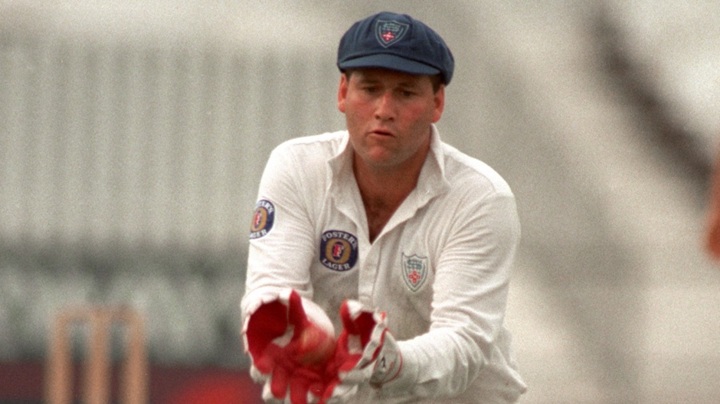Phil Emery: A Bowler's Tribute to his Keeper
Richard Stobo | July 06, 2025

I had the privilege of bowling to some outstanding wicketkeepers over the years – Greg Dyer, Mark Atkinson, David Moore, Paul Ryan, and Adam Gilchrist immediately spring to mind.
Not a bad group by any measure.
But no one matched my longtime teammate, Phil Emery. The reason is simple. Embers knew my game inside out and made me a better player than I would’ve been otherwise.
People don’t always realise how vital a keeper is to a fast bowler. Their importance to spinners is obvious – stumpings, catches close to the wicket, the “Well bowled, Warnie!!” and “Nice one, Garryyyyy!!”.
But with quicks, keepers can sometimes look like glorified backstops (who fall over down leg side and get applauded for it! “Great stop!!”)
Nothing could be further from the truth.
When bowling to the top-order, I mainly bowled for edges. Rarely aimed at the stumps – I learned after a few years that the good players take anything on off-stump and work it through the leg side. At first, I thought they were taking risks. Later, I understood they were just bloody good and knew how to move their feet. Good batsmen are rarely bowled, seldom trapped LBW, and barely ever caught in the ring. That meant the edge was everything.
Which meant the keeper and slips were everything. I wasn’t bowling to the batsman as much as I was bowling for the blokes standing behind him. I was always trying to bring them into the game.
And with men like Mark O’Neill, Steve Day, Adam Gilchrist (when Embers was away with NSW), Greg Hayne and Paul McLean in the cordon – and Phil behind the stumps – I just had to do my bit. They did the rest. That gave me the confidence every bowler needs.
Phil and I first crossed paths in late 1982, when we were about 17. He captained the GPS side; I was playing for the CAS. I took a few wickets that day but remember only one.
Phil came in after I’d dismissed an opener. I’d heard of him as a cricketer, but I only found out he was a left-hander when he took strike.
First ball: uncontrolled down leg-side. Second ball: uncontrolled outside off.
I remember that he looked down the wicket at me with that look of ‘Really??’
Third ball: an in-swinging yorker that smashed into his middle stump.
He’d fallen for the old three-card trick. Who’d have thought?
Maybe not, but one of our blokes gave him a send-off all the way back to the pavilion. I know it still rankles.
We became close mates after the HSC and spent a lot of time kicking around together. Looking back, that’s probably when our bowler-keeper combination truly began – before we’d even played on the same team.
Our first game together was in 4th Grade for Gordon against Balmain at Ryde Oval, around New Year, 1982-83. My memory’s hazy, but the wonderful Gav Robertson was playing for Balmain and took six wickets to win the match. Forty years on, we’re all still mates.
(An aside: Are the days when future Test and Shield players pay their dues and learn their craft from the old heads in the lower grades well and truly gone? I fear so, and more’s the pity.)
Phil and I progressed to 3rd Grade together a week or two later, before injury to the 2nd Grade keeper saw him elevated once again. Phil’s talent was screamingly obvious, and he was in 1st Grade before the season was out. I joined him early next season, and I don’t think either of us missed a match for Gordon through injury for the next 11 years. Possibly, but I can’t recall it.
The early and mid ’80s were tough for Gordon. The ’70s had been a golden era, but now the wicket at Chatswood was pretty poor, and we had to play half our games there. We had some terrific, experienced players – Phil Antman, Trevor Chappell, Michael Falk, Ro McGregor, Greg Evans – but we still struggled.
I still had a lot to learn about bowling in 1st Grade – it would take few seasons – while Phil, who’s keeping was excellent, couldn’t quite put together the break-through innings to establish himself as one of the premier young batsmen in the competition.
That began to change in 1985-86, with the arrival of Mark O’Neill (Sparky), Andy Knight, and Steve Day. More than just great players, they were terrific teammates, and it was finally becoming our team.
Chatswood Oval hadn’t improved much and we still had our share of losses, but at least there were encouraging signs. In particular, in Sparky, Phil finally had someone who could help take his batting to the next level.
Embers truly hit his stride with the bat in 1986-87. After a few lean scores, he and Sparky put together a partnership for the ages – 326* for the third wicket against Fairfield at Chatswood. It’s still the highest 3rd wicket partnership in 130 years of Sydney grade cricket. Importantly, Embers probably learned more about batting in those five hours with Sparky than he had the previous five years. It was his first 1st Grade century, and he followed it up with another soon after. The floodgates had opened.
Within two seasons, he was playing for NSW in the first of his 120 first-class matches (which included nearly 400 dismissals) – an extraordinary feat.
But back to his keeping.
What always stood out to me about Phil’s keeping was that he never stood out.
That was his brilliance. No theatrics, just rock-solid reliability.
His glovework and footwork were first-class in every sense. He never tumbled – everything was taken cleanly, under the eyes or on the inside hip. When he did have to dive, it was with precision and reach, and because his footwork had already put him in the right spot, he covered a lot of ground.
Standing up to the stumps? No one better in the country.
And no byes. That was always a matter of real pride for him, and with good cause.
Phil also set a high standard for us in the field. He trained incredibly hard, and was always moving as well behind the stumps at 6 PM as he had been at 11 AM. He took pride in getting out to returns on the full – maybe unnoticed by many, but it made us look sharper in the field than perhaps we sometimes were, particularly late in the day.
I liked to think I was a pretty decent fielder, but if I ever threw in something ordinary, I’d get that look. Never angry – just a raised eyebrow from a mate who knew I was better than that … “Really?”
And – crucially for me – we were pretty much always on the same page when I was bowling. He knew me well, what I was capable of, and what I wasn’t. He also knew I was never one for motivational garbage; just a quiet word as he jogged past between overs (and Phil always jogged between overs) did the trick.
It was a good combination, and I reckon it worked well.
(Although he did enjoy moving my mark around occasionally, which he though was funny. Me, not so much when I was half way in for the first delivery of the next over, and out of stride. )
Phil’s NSW mentor, Steve Rixon, was a brilliant keeper himself and set a tough standard. Phil worked unbelievably hard at state trainings to meet it, and once he’d received his opportunity to keep for NSW, he made sure he worked even harder to keep pretenders at bay.
And there were a few, because Sydney was flush with terrific keepers at that time: those I mentioned earlier, but add Andrew Millican, Craig Glassock, Nigel Taylor, Tim Ebbeck, etc.
Adam Gilchrist had to leave Gordon and then NSW to get a regular keeping spot because Phil was in front of him. The defence rests.
Two moments sum up Phil’s keeping.
Both came in the 1990-91 1st Grade Final against a strong Mosman side. Defending a modest 170 on a flattening wicket, we needed early breakthroughs.
First, a brilliant diving catch down leg side late in the day to remove opener Scott Atkinson off Warwick Adlam. I had the perfect view from behind square. Unforgettable.
Then, with the match in the balance, Gary Bensley – a terrific, experienced cricketer – bottom-edged a wrong’un from Sparky. Embers took it cleanly. Brilliant.
Both left-handed batsmen, leaving Embers unsighted for a moment.
I’m not sure how many games we played together for Gordon—probably around 100, from 1983-84 to 1993-94. Phil played fewer in my last six years due to state duties, and I missed a few as well. I read somewhere that we combined for about 60-70 dismissals in 1st Grade. Not bad, though it could’ve been more if I’d have bowled better early on!
Phil played one Test match, against Pakistan at Lahore in 1994, after an injury to Ian Healy. In the second innings, he took four catches (three of McGrath) and made stumping off Warne. Not a bad in trying conditions, and with a broken thumb.
He was unlucky not to play many more.
Cheers, mate.
A Gordon.
Get fah, ya bah!
Richard Stobo
BeaconPoint Club Clips - Why Leadership in Community Sport is important with Pat Cummins - Australian Cricket captain










